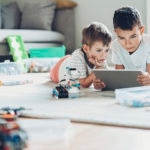Digital divide and the pandemic: One in ten households with students has no internet access
The mass closure of schools, colleges and universities in the 2019-2020 academic year proved that not all schools, teachers, students and families were ready to teach and learn online. One in ten households with school-age children have no Internet access, according to the Instituto Nacional de Estadística, Spain's national statistical institute. Due to the pandemic, technological resources and training in using them effectively is more important than ever. The risk surrounding the digital divide is serious.

According to data from the Instituto Nacional de Estadística, 91.4% of Spanish households have Internet access: one in 10 households are disconnected. 9.2% of lower-income households cannot connect to the network, according to UNICEF. The foundational step of providing resources must be followed by training. “The data tells us 55% of the Spanish population has only very basic digital skills,” said Eulalia Alemany, technical director of Fad (Spain's foundation for aid against drug addiction).
To give it a boost, BBVA and Fad launched Educación Conectada (“connected education”). This was an “emergency response,” said Alemany. In view of the situation of households and the demands of the teaching community, the initiative aims to “make a proactive contribution to the digital transformation of the Spanish education system.” Educación Conectada offers training activities to help close what experts call the “use divide.”
It's not just having the devices, it's knowing how to use them
The first step is a diagnosis for each school. Each school can choose its own training program: digital skills, crisis management, or leadership. “We will showcase success stories of digital transformation and transfer of knowledge from other sectors,” said Alemany. Parents can get “info pills” to support their children in a hybrid or bimodal learning format (face-to-face combined with digital education). For students, the program offers “gamified” distance learning on office automation, mailing or text editing.

Young people believe in technology, and are clear on how it should be approached: to improve health and protect the environment, according to the Barometer on Youth and Technological Expectations presented at an online event hosted by BBVA, Fad and Google. “Adults downplay the adverse effects with the notion that “they're digital natives, they know what they're doing,” said Laura Picazo, who emphasizes the importance of digital, audiovisual and media literacy. “They can handle the technology, but they don't understand how it works: why they have to change privacy settings so that their data is not given away, or what happens if they hit one tab or another,” she continued.
BBVA and Fad (Spain's foundation against drug addiction) launched the Educación Conectada “connected education” project, which includes emergency actions aimed at education following the crisis caused by COVID-19. The goal is to alleviate the severity of the crisis and support the digital transformation.
“There's no such thing as a digital native—people need guidance,” Alemany stated with conviction. “Turning 18 doesn't mean you can drive. You first need to learn to drive, right? Well, this is the same kind of thing,” she added. The technical director of Fad advocates smartphones as a “great learning tool.” For one thing, 99.9% of young people already have a smartphone almost glued to their hand. “But, again, we need to teach them how to use it properly—how to make smart use of it,” she stated. She underscored that, when used properly, a smartphone is a window on the world.